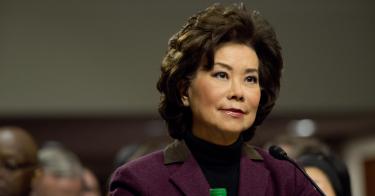When Elaine L. Chao appeared before the Senate committee considering her nomination to serve as the nation’s next secretary of Transportation, she ably fielded questions on issues ranging from the solvency of the Highway Trust Fund to privatizing air traffic control.
But one critical topic came up time and again: the Department’s approach to revolutionary emerging technologies. Autonomous vehicles may one day virtually eliminate traffic fatalities and congestion. Drones, Chao noted, are “transforming the way we work, the way we do commerce.” One American company, Zipline, is using drones to deliver critical medical supplies. Not in America, though; in Rwanda. Another American company, Amazon, just completed its first drone delivery… in the UK.
Why are American companies achieving these historic firsts abroad?
The fault lies largely with regulators at the Federal Aviation Administration. The FAA has not kept pace with developments in the industry, and has banned all but the most basic commercial activities until it can catch up.
Officials have sought to justify this command-and-control approach on safety grounds. But they exaggerate and misrepresent the harms and risks of drones, and in the process, stoke public fears of aviation disasters. In reality, not a single collision between a drone and a jet airliner has occurred, and little data exists to indicate how serious such a collision might be.
Meanwhile, the agency has wrongly determined that drones are “aircraft” for the purposes of federal law, exposing millions to criminal prosecution for inadvertent – and sometimes unavoidable – violations of aviation laws that were clearly written to address manned aviation. Even an FAA drone task force took issue with this, but the bureaucracy pressed on.
The FAA is systematically creating a regulatory framework that places itself at the head of an industry. This approach suffers from a flawed conceit: that regulators, not entrepreneurs and consumers, know best. With nations such as the UK waiting with open arms, we should not be surprised when companies take their operations, and all the consequent benefits, abroad.
Clearly, we need fresh thinking and a new approach.
At her hearing, Chao laid out a vision for regulation that sounds quite different from what has been outlined above.
“First and foremost, safety will continue to be the primary objective. Regulatory decisions should be rooted in analysis derived from sound science and data, with risk-based analysis… and that considers both the costs and the benefits of new rulemakings.”
She later called this method “the best way we protect consumers,” and asserted that regulators can and should promote safety without “dampen[ing] the basic creativity and innovation” that makes our dynamic, world-leading economy possible.
That dynamism does not come without its struggles, and public acceptance of new technologies is one of them. For the most part, technological advance follows a familiar curve: initial public skepticism gives way to gradual adoption, until finally the product – whether it be cameras, smartphones, or drones – is so thoroughly integrated into modern life that it is taken for granted. Future generations almost invariably puzzle at the luddites who once were so concerned with such a mundane thing.
By and large, new technologies – drones included – can be folded into existing, technology-agnostic criminal, tort, product liability, property, and privacy laws, with emendations when some specific new harm arises.
Sometimes, though, regulators might capitalize on early public fears to preempt this process, and thereby expand their own regulatory authority. Secretary Chao hinted at her preference for an alternative approach. During an exchange on driverless cars with Sen. Gary Peters (D-Mich.), she said:
“What we are seeing is obviously technology outstripping the consumer ability to accept and understand the technology. It behooves all of us… to bring greater familiarity and greater comfort, for passengers and other stakeholders who will be eventual users of this technology, to understand the benefits, the limitations, and also what it means going forward in the future.”
When Senator Jim Inhofe (R-Okla.) raised the question of regulatory hang-ups for drones, Chao responded in similar fashion, calling for a dialogue to develop a “national consensus” on the best path forward. She noted that there are safety, security, and privacy concerns, but also enormous and transformative potential benefits that need to be taken into account.
Throughout her testimony, Chao stressed time and again the crucial role innovation, creativity, and technology play in building America’s economy, creating opportunity, and raising our standard of living. As for regulators, “[t]he role of government,” she said, “is to foster the right environment through which job creation can occur.”
That is precisely the attitude America needs at the helm of the Department of Transportation.
This piece originally appeared in The Hill


